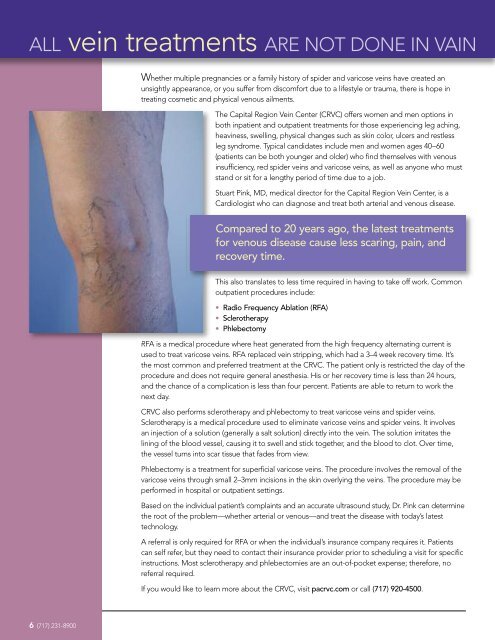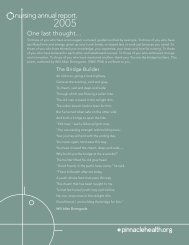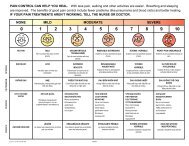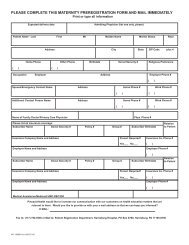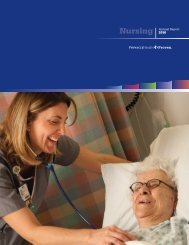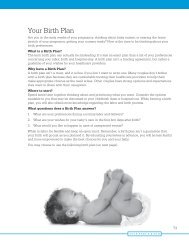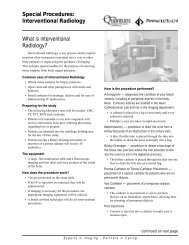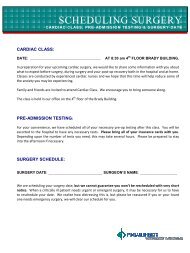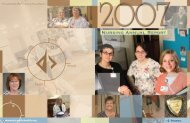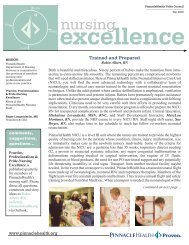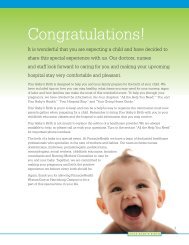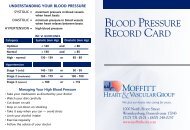Mary McCurdy - PinnacleHealth
Mary McCurdy - PinnacleHealth
Mary McCurdy - PinnacleHealth
You also want an ePaper? Increase the reach of your titles
YUMPU automatically turns print PDFs into web optimized ePapers that Google loves.
ALL vein treatments ARE NOT DONE IN VAIN<br />
Whether multiple pregnancies or a family history of spider and varicose veins have created an<br />
unsightly appearance, or you suffer from discomfort due to a lifestyle or trauma, there is hope in<br />
treating cosmetic and physical venous ailments.<br />
The Capital Region Vein Center (CRVC) offers women and men options in<br />
both inpatient and outpatient treatments for those experiencing leg aching,<br />
heaviness, swelling, physical changes such as skin color, ulcers and restless<br />
leg syndrome. Typical candidates include men and women ages 40–60<br />
(patients can be both younger and older) who find themselves with venous<br />
insufficiency, red spider veins and varicose veins, as well as anyone who must<br />
stand or sit for a lengthy period of time due to a job.<br />
Stuart Pink, MD, medical director for the Capital Region Vein Center, is a<br />
Cardiologist who can diagnose and treat both arterial and venous disease.<br />
Compared to 20 years ago, the latest treatments<br />
for venous disease cause less scaring, pain, and<br />
recovery time.<br />
This also translates to less time required in having to take off work. Common<br />
outpatient procedures include:<br />
• Radio Frequency Ablation (RFA)<br />
• Sclerotherapy<br />
• Phlebectomy<br />
RFA is a medical procedure where heat generated from the high frequency alternating current is<br />
used to treat varicose veins. RFA replaced vein stripping, which had a 3–4 week recovery time. It’s<br />
the most common and preferred treatment at the CRVC. The patient only is restricted the day of the<br />
procedure and does not require general anesthesia. His or her recovery time is less than 24 hours,<br />
and the chance of a complication is less than four percent. Patients are able to return to work the<br />
next day.<br />
CRVC also performs sclerotherapy and phlebectomy to treat varicose veins and spider veins.<br />
Sclerotherapy is a medical procedure used to eliminate varicose veins and spider veins. It involves<br />
an injection of a solution (generally a salt solution) directly into the vein. The solution irritates the<br />
lining of the blood vessel, causing it to swell and stick together, and the blood to clot. Over time,<br />
the vessel turns into scar tissue that fades from view.<br />
Phlebectomy is a treatment for superficial varicose veins. The procedure involves the removal of the<br />
varicose veins through small 2–3mm incisions in the skin overlying the veins. The procedure may be<br />
performed in hospital or outpatient settings.<br />
Based on the individual patient’s complaints and an accurate ultrasound study, Dr. Pink can determine<br />
the root of the problem—whether arterial or venous—and treat the disease with today’s latest<br />
technology.<br />
A referral is only required for RFA or when the individual’s insurance company requires it. Patients<br />
can self refer, but they need to contact their insurance provider prior to scheduling a visit for specific<br />
instructions. Most sclerotherapy and phlebectomies are an out-of-pocket expense; therefore, no<br />
referral required.<br />
If you would like to learn more about the CRVC, visit pacrvc.com or call (717) 920-4500.<br />
6 (717) 231-8900


